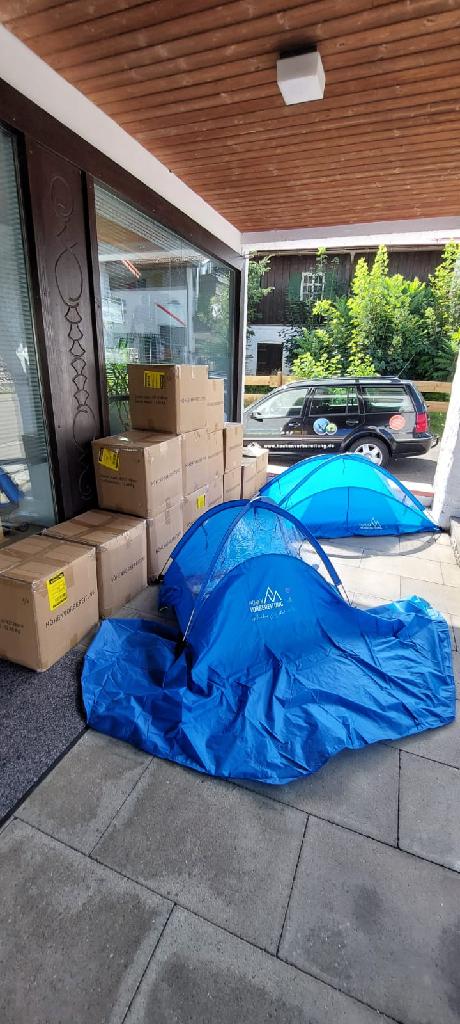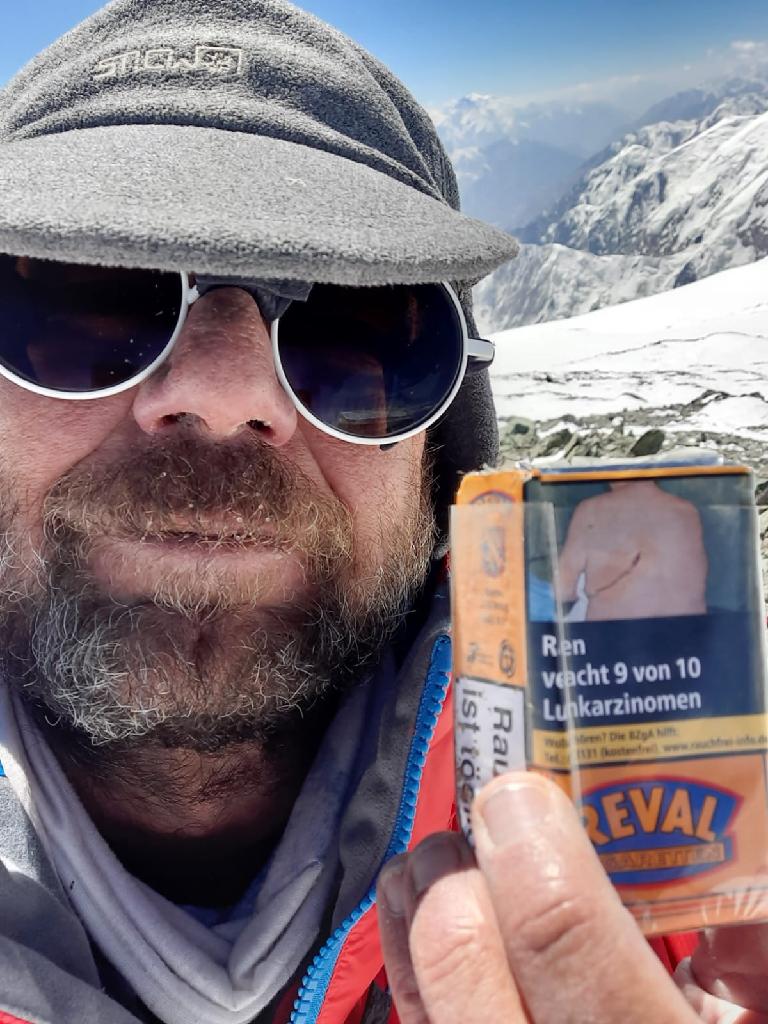Not A Good Idea?
Posted by Jeremy Windsor on Oct 11, 2024
Earlier this year a group of health care professionals were invited to Kyrgyzstan by the Slava Topol Project. Our aim was to see whether it was possible to set up a coordinated rescue service on Lenin Peak (7134m). Along the way we met some fascinating people who generously shared their stories. Here’s Hermann Sowade who surprised many of us by reaching the summit...
Thanks Hermann for talking to me. Can I start by asking you to tell us about yourself?
Hi, I am Hermann Sowade from Bavaria, Germany. Born in 1963, I’m 61 years old. I grew up on a farm in Füssen near the Austrian border and started mountaineering at the age of 10. At 12 years of age I summited the Zugspitze (2963m) - the highest mountain in Germany. I started rock climbing at 15 and went on to make first ascents in the Alps rated UIAA IX- (5.12a). My favourite activities as a teenager were survival training, hang gliding, sailing in self built boats, motor biking in winter and trying out many things that others didn´t dare to try!
I studied Geology in Munich and completed my diploma thesis in the Rocky Mountains of British Columbia, Canada. I washed the gold for our wedding rings in the jungle of Venezuela, the diamonds inserted in the rings are also deposits from the same area. In recent decades I have worked as an environmental geologist in Munich, Germany, in order to feed my children!
What drew you to Lenin Peak?
Last year I decided to climb a high mountain for my 60th birthday. Up to then, I had never been above 4200m. I decided on Khan Tengri (7010m) in the Tien Shan Mountains of Kyrgyzstan. I failed. Why? Insufficient acclimatisation. I developed a high altitude illness at 5300m. As a smoker (about 1 packet a day), I expected to get high altitude pulmonary oedema (HAPE), but surprisingly I got high altitude cerebral oedema (HACE) instead! With the help of other climbers I descended to Khan Tengri Base Camp with only serious damage being done to my pride.
Analyzing my experience in the aftermath, I realised that this was not a good mountain to start with*. So I decided to try Pik Lenin (7134m) this year, where there are optimal possibilities for acclimatising.
Can you tell us about your chronic obstructive pulmonary disease (COPD)?
Before going out to Lenin Peak this year, I had a medical check, done by a friend of mine. She sent me to a professor who specialises in pulmonary deseases and high altitude medicine. Prof Rainald Fischer in Munich diagnosed me with COPD GOLD III**. I had no idea up to then. But of course in hindsight...

The hypoxic tent used by Hermann in preparation for Lenin Peak
What symptoms did you encounter at first? What treatment do you use?
Well, in hindsight, there were symptoms of course, that I persistently ignored. At 49, I climbed a mountain in the Alps called Schafreiter (2100m), doing 1300m in one go. But the last 300m took me about 2 hours, which I couldn’t explain. Lack of exercise? Too much booze the night before? Old age??? Some years later I was on my favourite Via Ferrata on the Alpspitze (2500m), where there is about 1200m of pure rock climbing. I call it my "sunday afternoon walk" and suddenly in the middle of climbing, I had the serious impression, that it would be NO GOOD IDEA to proceed today. I turned around and even took a cable cabin back to the valley. When coming back from the Caucasus about 7 years ago, I caught a severe lung infection, presumably in the underground of Tbilisi. So I lay sick and in the middle of the night I woke up panicking that I might suffocate. I could not breathe enough. So I went out to catch some fresh air and was on the brink of calling an ambulance. When pondering this, I told myself: you always wanted to climb a high mountain - there is even less air up there. With this comfort, I went back to bed and slept well.
On Lenin Peak, I was aware that this would mean pushing my limits to the extreme. According to Prof Fischer, my forced expiratory volume is 40% of what is predicted for me. Together with the HACE I developed last year on Khan Tengri, the only way for me to get up Lenin Peak was to ascend very slowly and take lots of rest days in between.
Treatment: before Lenin Peak none. On Lenin Peak I took Ibuprofen 600mg twice a day and used an inhaler - Spiolto (Tiotropium/Olodaterol) 5µg once a day, normally at 7 a.m. It increases my lung capacity. To avoid any side effects I would sometimes skip the daily dose or when there was an early start the following morning (e.g. 2am) or sometimes I just forgot to take it! When I went on an acclimatisation climb of Yuchin Peak (5100m) with Yasmin Down, I had forgotten to inhale in the morning and it had no negative effect. We even overtook another group that had started 2 hours ahead of us.
You prepared for Lenin Peak using a hypoxic training device. What can you tell me about it?
The idea to use a hypoxic tent was Prof Fischer’s. After the diagnosis of COPD, I asked him whether there was any chance of me climbing a high mountain and he suggested that I use a hypoxic tent and keep going with the pharmaceutical assistance (cheating by doping, you may call it!). So I rented this tent about 2 weeks ahead of my trip to Kyrgyzstan. The company even provided me with an exact training plan tailored to my needs.
The tent I used was mounted on the bed and provided enough room for my chest and head. There are other models for 2 persons. To simulate the height, the generator reduced the partial pressure of oxygen I inhaled to below that normally seen in my bedroom. The generator is a bit noisy, so ideally it should be placed outside the bedroom. A hose connects to the tent, providing the hypoxic air. The best thing about the tent: there were no mosquitoes inside and I could even read books in there. The normal way is to sleep in there, starting with an oxygen partial pressure that is comparable to a height of 2000m. Every night, this height is increased by 400m as long as no negative symptoms show. Otherwise the height level is reduced for a night or two. Of course, I wanted to push it and went from 2400 m to 4000 m in one step. NOT A GOOD IDEA! It gave me a headache after 2 hours, and I threw off the tent for the rest of the night. I then kept to the regular nightly increase and in the end slept like a baby at a simulated height of 4000 m for 4 nights. There was daytime training recommended as well, using a mask and doing exercises. But I skipped that because of being lazy. Once after sleeping at simulated 4000 m, I tried doing exercises at a simulated height of 6000m. It worked! Side effects - almost none, sometimes a bit dizzy in the morning. And no mosquito bites!

Hermann celebrating on the summit of Lenin Peak!
The million dollar question is “do you think it helped?”
YES! I went to Base Camp (3600m) within eight days of my last night in the hypoxic tent (inbetween there were some unavoidable parties in Bishkek) and I felt well there. No dizziness at this height, but nonetheless I stayed in Base Camp for 5 days, making tours from there to fully acclimatise. There was always the fear in the back of my mind, that if I caught a high altitude illness again, that was it for the summit. So I went very slow and carefully.
Would you use hypoxic training again?
Yes, the hypoxic tent helped me a lot. And given I’ll climb another of the big ones, it will be used for preparation again. Maybe a bit longer than the 12 days of last time. But always at the last possible moment before going off to the mountain. Of course, it would be helpful to do the whole training programme with day time exercises, but I´m lazy...
Do you think your COPD affected your performance at altitude?
COPD was the main issue that hindered me. As my FEV1 is down to 40%, it was like climbing at a much higher altitude, given the reduced intake of oxygen. It slowed me down a lot!
Some 30 years ago, I felt at home with climbing at a speed of 600m/hour, 800 or 1000m/hour was possible. But as I am lazy, I never liked fast climbing. Now I am going at 400m/hour in the Alps. Once above 5000m, as a rule of thumb, altitude gain is reduced by 50% every additional 1000 m of height. So this slowed me down to less than 100 m/hour above 7000m. I am fully aware that trying to summit a 8000er with this performance would kill me!
Has it persuaded you to stop smoking?
No. This was the main advice from Prof Fischer: Stop smoking at once! I couldn't but refrained from smoking for 24 hours before going to higher altitude. Why? Smokers have part of their haemoglobin molecules blocked by carbon monoxide. And by stopping smoking, there is additional haemoglobin available. I call this nicotine doping!
*To access Khan Tengri it is necessary to take a helicopter into Base Camp (4000m).
**The GOLD grading system is means by which COPD patients can be matched to appropriate treatment. The system takes into account symptoms, number of exacerbations and hospital admissions, as well as a measurement of forced expiratory volume in one second (FEV1). For further information on the GOLD grading system take a look at this.
Thanks Hermann - it was a pleasure meeting you on Lenin Peak! All the best with your future mountain adventures!
The Slava Topol Project seeks to improve safety on Lenin Peak. To find out more and make a donation please click on this link.
If this is your sort of thing why not take a look at other posts on the blog?
Better still, why not join the British Mountain Medicine Society! More information can be found here.
For more on the University of Central Lancashire's Diploma in Mountain Medicine take a look at this.
Comments
Leave a comment.



 )
)